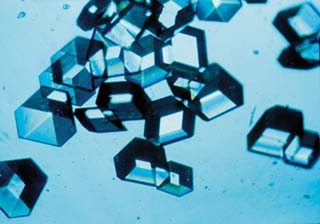Crystal

In chemistry, mineralogy, and materials science, a crystal is a solid in which the constituent atoms, molecules, or ions are packed in a regularly ordered, repeating pattern extending in all three spatial dimensions.
The word crystal originates from the Greek word κρύσταλλος (krystallos) meaning clear ice, as it was thought to be an especially solid form of water.[citation needed] The word once referred particularly to quartz, or "rock crystal".
Most metals encountered in everyday life are polycrystals.[citation needed] Crystals are often symmetrically intergrown to form crystal twins.
Crystal structure
Which crystal structure the fluid will form depends on the chemistry of the fluid, the conditions under which it is being solidified, and also on the ambient pressure. The process of forming a crystalline structure is often referred to as crystallization.
While the cooling process usually results in the generation of a crystalline material, under certain conditions, the fluid may be frozen in a noncrystalline state. In most cases, this involves cooling the fluid so rapidly that atoms cannot travel to their lattice sites before they lose mobility. A noncrystalline material, which has no long-range order, is called an amorphous, vitreous, or glassy material. It is also often referred to as an amorphous solid, although there are distinct differences between solids and glasses: most notably, the process of forming a glass does not release the latent heat of fusion. For this thermodynamic reason, many scientists consider glassy materials to be viscous liquids rather than solids, although this is a controversial topic; see the entry on glass for more details.
Crystalline structures occur in all classes of materials, with all types of chemical bonds. Almost all metal exists in a polycrystalline state; amorphous or single-crystal metals must be produced synthetically, often with great difficulty. Ionically bonded crystals can form upon solidification of salts, either from a molten fluid or when it condenses from a solution. Covalently bonded crystals are also very common, notable examples being diamond, silica, and graphite. Polymer materials generally will form crystalline regions, but the lengths of the molecules usually prevents complete crystallization. Weak Van der Waals forces can also play a role in a crystal structure; for example, this type of bonding loosely holds together the hexagonal-patterned sheets in graphite.
Most crystalline materials have a variety of crystallographic defects. The types and structures of these defects can have a profound effect on the properties of the materials.
Other meanings and characteristics
Since the initial discovery, made in 1982 by Dan Shechtman, the acceptance of the concept and the word quasicrystal have led the International Union of Crystallography to redefine the term crystal to mean 'any solid having an essentially discrete diffraction diagram', thereby shifting the essential attribute of crystallinity from position space to Fourier space. Within the family of crystals one distinguishes between traditional crystals, which are periodic on the atomic scale, and aperiodic crystals which are not. This broader definition adopted in 1996 reflects the current understanding that microscopic periodicity is a sufficient but not a necessary condition for crystallinity.
While the term "crystal" has a precise meaning within materials science and solid-state physics, colloquially "crystal" refers to solid objects that exhibit well-defined and often pleasing geometric shapes. In this sense of the word, many types of crystals are found in nature. The shape of these crystals is dependent on the types of molecular bonds between the atoms to determine the structure, as well as on the conditions under which they formed. Snowflakes, diamonds, and common salt are common examples of crystals.
Some crystalline materials may exhibit special electrical properties such as the ferroelectric effect or the piezoelectric effect. Additionally, light passing through a crystal is often refracted or bent in different directions, producing an array of colors; crystal optics is the study of these effects. In periodic dielectric structures a range of unique optical properties can be expected as sawed in photonic crystals.
Crystallography is the scientific study of crystals and crystal formation.
Crystalline rocks
Inorganic matter, if free to take that physical state in which it is most stable, always tends to crystallize. Crystalline rock masses have consolidated from aqueous solution or from molten magma. The vast majority of igneous rocks belong to this group and the degree of crystallization depends primarily on the conditions under which they solidified. Such rocks as granite, which have cooled very slowly and under great pressures, have completely crystallized, but many lavas were poured out at the surface and cooled very rapidly; in this latter group a small amount of amorphous or glassy matter is frequent. Other crystalline rocks, the evaporites such as rock salt, gypsum and some limestones have been deposited from aqueous solution, mostly owing to evaporation in arid climates. Still another group, the metamorphic rocks which includes the marbles, mica-schists and quartzites; are recrystallized, that is to say, they were at first fragmental rocks, like limestone, shale and sandstone and have never been in a molten condition nor entirely in solution. The high temperature and pressure conditions of metamorphism have acted on them erasing their original structures, and inducing recrystallization in the solid state.[1]
See also
References
External links
- Introduction to Crystallography and Mineral Crystal Systems
- Crystallographic Teaching Pamphlets
- Crystal Lattice Structures
- The Giant Crystal Project - documenting the largest crystals and crystal aggregates known to exist
ar:بلورة bg:Кристал ca:Cristall cs:Krystal da:Krystal de:Kristall et:Kristall el:Κρύσταλλος eo:Kristalo fa:بلور ko:결정 hr:Kristal io:Kristalo id:Kristal it:Cristallo he:גביש la:Crystallum lv:Kristāls lt:Kristalas mk:Кристал nl:Kristal (natuurwetenschappen) nn:Krystall ug:كىرىستلا sl:Kristal sr:Кристал fi:Kiteinen aine sv:Kristall ta:படிகம் th:ผลึก yi:קריסטאל